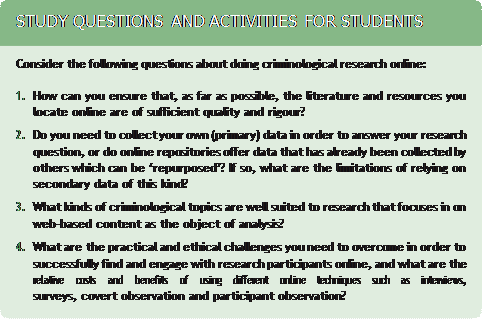 |
Summary and review
|
|
|
|
This chapter has overviewed a variety of ways that the internet may prove useful for those doing criminological research. First, it provides a valuable range of freely accessible resources including articles that can serve as the basis of your literature review and secondary data that you can use as the basis for answering your own research questions. Second, it considered how web-based content can provide the basis for a criminological study, including, for example, crime-related discourse and criminal behaviour found on websites and social media platforms. Third, it examined how you might use the internet to find and engage research participants, by adapting familiar research techniques (interviews, surveys) to the online setting. Fourth, it introduced the practice of virtual ethnography, where the researcher engages in par- ticipant observation of online groups and communities. A number of case studies and examples have been offered to illustrate how these techniques have been put to practical use by social and criminological researchers. All of the above approaches offer important new avenues for the researcher to explore criminological topics, but they also have some drawbacks and limitations as well as advantages and benefits, and these have been noted so that you can take them into account when planning and executing your own research project.




 Andrews, D., Nonnecke, B. and Preece, J. (2003) ‘Electronic survey methodology: a case study in reaching hard-to-involve internet users’, International Journal of Human- Computer Interaction, 16(2): 185–210.
Andrews, D., Nonnecke, B. and Preece, J. (2003) ‘Electronic survey methodology: a case study in reaching hard-to-involve internet users’, International Journal of Human- Computer Interaction, 16(2): 185–210.
Banks, J. (2013) ‘Edging your bets: advantage play, gambling, crime and victimisation’,
Crime, Media, Culture, 9(2): 171–87.
Bergman, M. K. (2001) ‘White paper: the deep web – surfacing hidden value’, Journal of Electronic Publishing, 7(1): 1–17.
Biernacki, P. and Waldorf, D. (1981) ‘Snowball sampling: problems and techniques of chain referral sampling’, Sociological Methods & Research, 10(2): 141–63.
Bishop, J. (2013) ‘The art of trolling law enforcement: a review and model for implementing “flame trolling” legislation enacted in Great Britain (1981–2012)’, International Review of Law, Computers & Technology, 27(3): 301–18.
Brotsky, S. R. and Giles, D. (2007) ‘Inside the “pro-ana” community: a covert online par- ticipant observation’, Eating Disorders, 15(2): 93–109.
Bryman, A. (2012) Social Research Methods, 4th edition. Oxford: Oxford University Press. Chamberlain, J. M. (2013) Understanding Criminological Research: A Guide to Data
Analysis. London: Sage.
Chermak, S. (1995) ‘Image control: how police affect the presentation of crime news’,
American Journal of Police, 14(2): 21–43.
Conway, M. (2016) ‘Determining the role of the internet in violent extremism and terrorism: six suggestions for progressing research’, Studies in Conflict & Terrorism, 40(1): 77–98. Dinev, T. (2006) ‘Why spoofing is serious internet fraud’, Communications of the ACM,
|
|
|
49(10): 76–82.
Duffy, M. E. (2003) ‘Web of hate: a fantasy theme analysis of the rhetorical vision of hate groups online’, Journal of Communication Inquiry, 27(3): 291–312.
Elgesem, D. (2002) ‘What is special about the ethical issues in online research? ’, Ethics and Information Technology, 4(3): 195–203.
Evans, M. P. (2007) ‘Analysing Google rankings through search engine optimization data’,
Internet Research, 17(1): 21–37.
Fichten, C. S., Tagalakis, V., Judd, D., Wright, J. and Amsel, R. (1992) ‘Verbal and nonverbal communication cues in daily conversations and dating’, The Journal of Social Psychology, 132(6): 751–69.
Friemel, T. N. (2016) ‘The digital divide has grown old: determinants of a digital divide among seniors’, New Media & Society, 18(2): 313–31.
Garcia, A. C., Standlee, A. I., Bechkoff, J. and Cui, Y. (2009) ‘Ethnographic approaches to the internet and computer-mediated communication’, Journal of Contemporary Ethnography, 38(1): 52–84.
Gerstenfeld, P. B., Grant, D. R. and Chiang, C. P. (2003) ‘Hate online: a content analysis of extremist internet sites’, Analyses of Social Issues and Public Policy, 3(1): 29–44.
Hale, C. (1996) ‘Fear of crime: a review of the literature’, International Review of Victimology, 4(2): 79–150.
Hammersley, M. and Atkinson, P. (2007) Ethnography: Principles in Practice. London: Routledge.
 Herring, S. C. (2009) ‘Web content analysis: expanding the paradigm’, in J. Hunsinger,
Herring, S. C. (2009) ‘Web content analysis: expanding the paradigm’, in J. Hunsinger,
M. Allen and L. Klastrup (eds), International Handbook of Internet Research. Dordrecht: Springer.
Hine, C. (2000) Virtual Ethnography. London: Sage.
Hirschi, T. (1969) ‘A control theory of delinquency’, in F. P. Williams III and M. D. McShane (eds), Criminology Theory: Selected Classic Readings. Cincinnati, OH: Elsevier.
Holt, T. J., Bossler, A. M. and Seigfried-Spellar, K. C. (2015) Cybercrime and Digital Forensics: An Introduction. Abingdon and New York: Routledge.
Internet Live Stats (2016) Total Number of Websites. Available at: www. internetlivestats. com/total-number-of-websites (accessed May 2018).
Internet World Statistics (IWS) (2015) World Internet Users and 2015 Population Stats. Available at: www. internetworldstats. com/stats. htm (accessed May 2018).
Jesson, J., Matheson, L. and Lacey, F. M. (2011) Doing Your Literature Review: Traditional and Systematic Techniques. London: Sage.
Jones, J. S. (2010) ‘Origins and ancestors: a brief history of ethnography’, in J. S. Jones and
S. Watt (eds), Ethnography in Social Science Practice. London and New York: Routledge. Khabsa, M. and Giles, C. L. (2014) ‘The number of scholarly documents on the public web’,
PloS One, 9(5): e93949.
Lee, E. and Leets, L. (2002) ‘Persuasive storytelling by hate groups online: examining its effects on adolescents’, American Behavioral Scientist, 45(6): 927–57.
McMillan, S. J. (2000) ‘The microscope and the moving target: the challenge of applying content analysis to the World Wide Web’, Journalism & Mass Communication Quarterly, 77(1): 80–98.
Mawby, R. C. (2002) ‘Continuity and change, convergence and divergence: the policy and practice of police–media relations’, Criminology and Criminal Justice, 2(3): 303–24.
|
|
|
May, T. (2011) Social Research: Issues, Methods and Process, 4th edition. Maidenhead: Open University Press/McGraw-Hill.
Meho, L. I. (2006) ‘E-mail interviewing in qualitative research: a methodological discussion’,
Journal of the American Society for Information Science and Technology, 57(10): 1284–95.
Nielsen, L. B. (2002) ‘Subtle, pervasive, harmful: racist and sexist remarks in public as hate speech’, Journal of Social Issues, 58(2): 265–80.
Palys, T. (2008) ‘Purposive sampling’, in L. Given (ed. ), The Sage Encyclopedia of Qualitative Research Methods, Vol. 2. Thousand Oaks, CA: Sage.
Patrick, J. (2013) A Glasgow Gang Observed. London: Neil Wilson Publishing.
Pearson, G. (2009) ‘The researcher as hooligan: where “participant” observation means breaking the law’, International Journal of Social Research Methodology, 12(3): 243–55. Pickett, J. T., Mancini, C. and Mears, D. P. (2013) ‘Vulnerable victims, monstrous offenders, and unmanageable risk: explaining public opinion on the social control of sex crime’,
Criminology, 51(3): 729–59.
Ragnedda, M. and Muschert, G. W. (2013) The Digital Divide: The Internet and Social Inequality in International Perspective. Abingdon and New York: Routledge.
Reid, E. (1996) ‘Informed consent in the study of on-line communities: a reflection on the effects of computer-mediated social research’, The Information Society, 12(2): 169–74.
 Riffe, D., Lacy, S. and Fico, F. (2014) Analyzing Media Messages: Using Quantitative Content Analysis in Research. London and New York: Routledge.
Riffe, D., Lacy, S. and Fico, F. (2014) Analyzing Media Messages: Using Quantitative Content Analysis in Research. London and New York: Routledge.
Schneider, C. J. (2016) ‘Police presentational strategies on Twitter in Canada’, Policing and Society, 26(2): 129–47.
Sillince, J. A. and Brown, A. D. (2009) ‘Multiple organizational identities and legitimacy: the rhetoric of police websites’, Human Relations, 62(12): 1829–56.
Thornberry, T. P. and Krohn, M. D. (2000) ‘The self-report method for measuring delinquency and crime’, Criminal Justice, 4(1): 33–83.
Wall, D. S. (2007) Cybercrime: The Transformation of Crime in the Information Age. Cambridge: Polity Press.
Williams, M. (2006) Virtually Criminal. London: Routledge.
Williams, M. (2008) ‘Cybercrime and online methodologies’, in R. D. King and E. Wincup (eds), Doing Research on Crime and Justice, 2nd edition. Oxford: Oxford University Press.
Yar, M. (2005) ‘The global “epidemic” of movie “piracy”: crime-wave or social construc- tion? ’, Media, Culture & Society, 27(5): 677–96.
Yar, M. (2013) Cybercrime and Society, 2nd edition. London: Sage.

|
|
|


